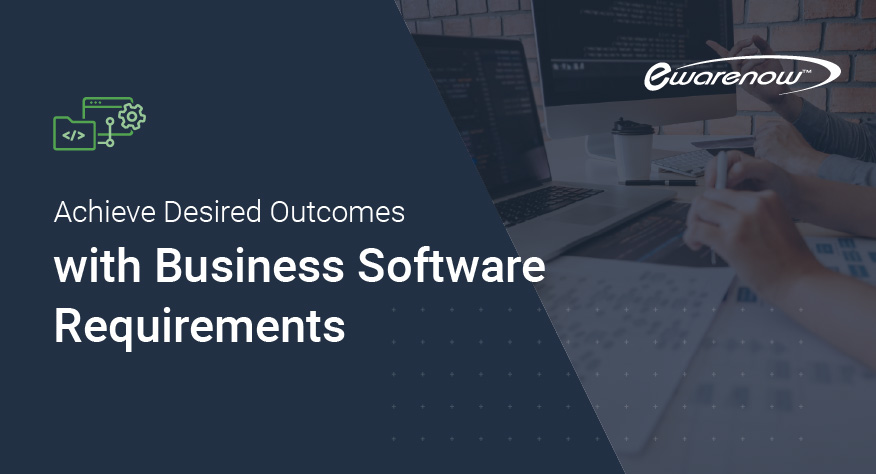Ewarenow Blog
How to Strategize Your Business Software Requirements

To develop strategic business software, you first must identify your company’s needs. The right approach will help you do smart requirements gathering. Then you can focus your custom software on meeting your desired business outcomes.
This article provides tips for creating an effective Business Requirements Document (BRD) to ensure your custom software solution is aligned with your company's needs as well as your desired business outcomes.
Achieve Desired Outcomes with Business Software Requirements
Before we get into the process of writing the BRD itself, we should explain three key terms that are often misused interchangeably. Understanding these terms and using them appropriately helps ensure clear communication with your chosen custom software development company.
Business Requirements vs. Functionality Requirements vs. Software Requirements
Business, functionality, and software requirements are three very different sets of requirements. However, identifying each group of requirements is essential to achieving your desired business outcomes with custom software.

Business Requirements
Business requirements are the highest level of goals or outcomes that the custom software project should help the company achieve. To identify them in relation to your custom software development project, you must focus on needs-finding.
An example of a business requirement could be, "Our website needs to make XYZ product accessible for purchase." By identifying a core need like this, you can direct the next actions to support or satisfy that requirement.
Functionality Requirements
Functionality requirements outline what a system must do in reaction to input. An example of a functionality requirement could be, "When customers click the sign-up button, they should each receive a welcome email." Unlike business requirements, functionality requirements focus on how you'll accomplish your goals.
Once you have your functionality requirements established, you can begin to outline the software requirements you will share with your selected custom software development partner.
Software Requirements
Software requirements cover what a program should do and how it will work within any necessary constraints. They may have both content-focused and content-independent characteristics.
A content-focused requirement could be, "You should see your payroll when you click this link," whereas a content-independent requirement might be, "This must appear and behave properly on both mobile and web interfaces."
Before You Get Started on Your BRD
Requirements gathering is vital, but it need not be overwhelming. Three simple steps can help you organize and carry out the process:
- Identify your requirements team
- Share information
- Establish key milestones
Step 1: Identify Your Team
The person who writes the BRD might be a Business Analyst, Project Manager, or someone who has a large stake in the outcome of the custom software development project. It is essential to include other upstream and downstream stakeholders who contribute different knowledge and perspectives.
An effective team will have three to five stakeholders who can and do commit sufficient time and enthusiasm to meet the goal of producing a solid BRD.
It is valuable to have at least one senior decision-making executive or their representative on the team or actively engaged in the sharing process.
Step 2: Share Information
Frequent in-person or online team meetings will help you identify and agree on diverse needs. Wider sharing and gathering of information will go further by helping you build a set of thorough, clearly stated, unbiased requirements.
Employ not only meetings but also surveys, interviews, and observations. Live observations are instrumental in witnessing the difficulties employees may be having with your current software.
Using employee feedback and data also can help you identify specific user requirements. User requirements are needs pertaining to key members of your business operations. An example might be that "Edgar from Finance needs to be able to access the monthly payroll."
Throughout the information-sharing and -gathering process, it is important to be open to continuously finetuning any and all requirements.
Step 3: Establish Key Milestones
Your teammates and those you share information with almost certainly have other duties beyond working on the BRD. So it is helpful to create and manage a set of key milestones with actionable steps. Then each person involved can factor the time for their contributions into their schedules and yours.
How to Write an Effective Business Requirements Document (BRD)
Congratulations! You have done the legwork, and now it's time to begin writing a BRD that is focused on your company's core needs and goals. A good outline of a BRD for custom software development consists of the following sections:
- Executive Summary: Outlines the project overview and main objectives.
- Business Challenge Statement: Highlights key problems to address, along with examples.
- Key Business Objectives: Should be in a SMART format.
- Requirements: May include functional requirements in addition to business ones.
- Project Constraints, Risks, and Limitations: May include information regarding your technology stack as well as any relevant research from past projects.
- Timeframe: Includes milestones. Also may include visual guides for intuitive understanding.
- Budget: Defines how much funding is available or allocated for the custom software development project.
Tip: Stakeholders who may not be experts in the subject matter may want or need to read your BRD. Therefore, it is important to ensure that your language is clear and free of jargon. Often times, you can achieve this by using charts, graphs, screen captures, and other visuals to help illustrate what you wish to accomplish.
Why Partner with Ewarenow for Custom Software Development
Ewarenow's mission is to understand your unique operations so we can produce a true custom software solution that meets your needs and helps you achieve your desired business outcomes. In other words, we create custom software to power YOUR business.
For more details, get in touch with us today.



